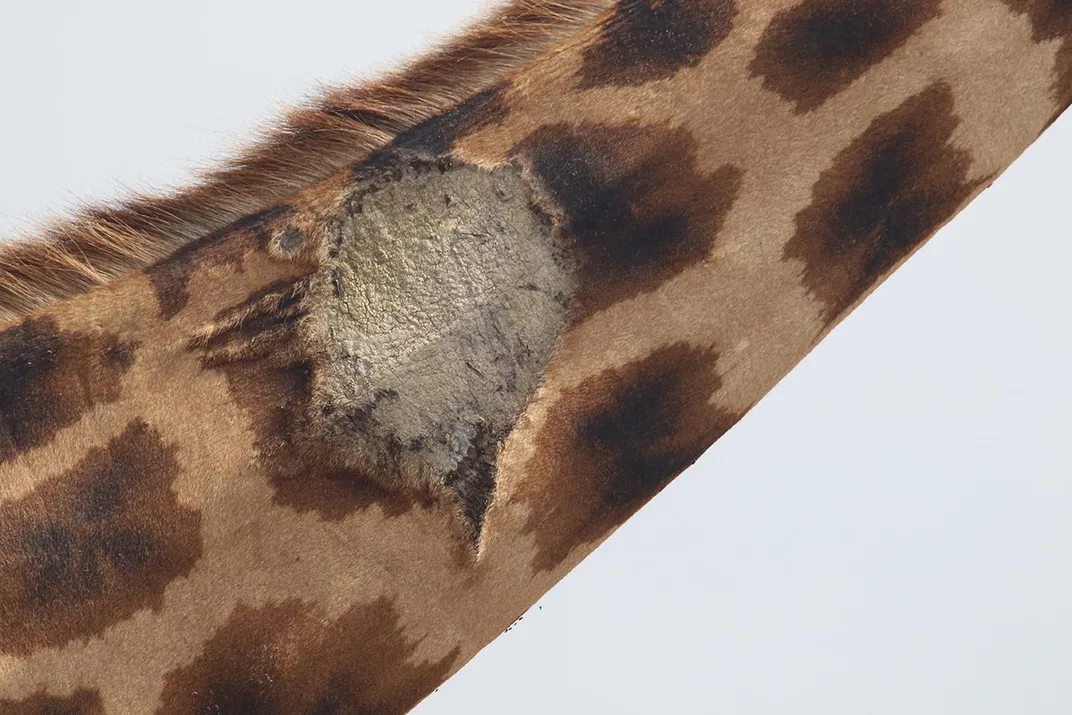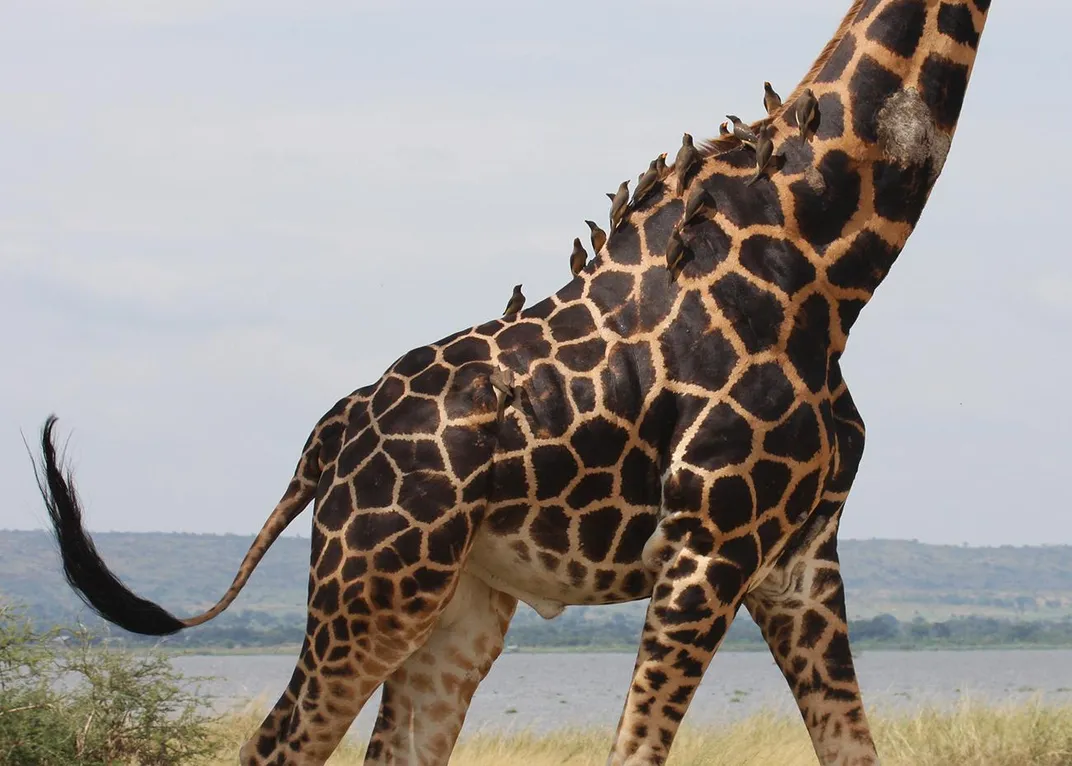How a Tiny Worm is Irritating the Most Majestic of Giraffes
They sound horrifying and look worse. A Smithsonian researcher is investigating the cause of these grotesque skin lesions
/https://tf-cmsv2-smithsonianmag-media.s3.amazonaws.com/filer/53/24/5324dda2-b8dc-40ca-8f56-614d6bf70967/bernarddupontflickr.jpg)
What is a fly to a giraffe?
It’s difficult to imagine a single insect even coming to the attention of these peculiar animals, which weigh in at thousands of pounds and routinely stretch their necks to heights of more than 14 feet. In Uganda’s Murchison Falls National Park, however, Michael B. Brown, a wildlife conservation researcher, has noticed something that might be harder to ignore: Whole clouds of insects swarming around the necks of these quadrupedal giants.
Under ordinary circumstances, such irritants might be unexceptional. But a growing body of evidence suggests that those flies might be linked to a more serious problem, a skin disease that seems to be spreading through giraffe populations across the continent. It sometimes takes the shape of holes in the animals’ flesh, circles of dead tissue, altogether distinct from the animals’ distinctive spots.
For giraffes, it’s just one problem among many—and it’s likely far less serious than the effects of climate change, poaching and habitat loss. But a better understanding of this ugly disease’s causes might help us make sense of the many other threats to these long-necked animals that have led wild giraffe populations to a precipitous decline—nearly 40 percent in the past 15 years.
According to a recent paper from the journal Biological Conservation, the giraffe skin disease “was first described in the mid-1990s in Uganda.” The Smithsonian National Zoo’s partners have identified similar lesions on giraffes in Tanzania and elsewhere. Since 1990, other possible evidence of the disease has been spotted in numerous other countries, including Namibia, Zimbabwe and Botswana. As the Biological Conservation paper’s authors note, however, it’s unclear whether the disease is becoming more common or whether we’re just getting better at spotting it as our ability to study giraffes improves.
One way to clear up that uncertainty would be to identify the disease’s etiology—the underlying cause of the problem, assuming there’s just one.
Kali Holder, an infectious disease researcher and veterinary pathologist at the National Zoo's Global Health Program, whose efforts has been supported by the Morris Animal Foundation, is working on a likely possibility: A tiny parasitic nematode that another Zoo pathologist spotted in samples of diseased tissue. The nematode, Holder suspects, could be carried by flies like those Brown has reported.
Studied through a microscope, the problem doesn’t look like much, especially to the untrained eye: on the slide that Holder showed me, a bright pink flush crept down the magnified chasm of a giraffe’s hair follicle. That discoloration, Holder said, is probably evidence of the hyperkeratotic areas—unusually thickened skin under attack by the giraffe’s own immune system—that Brown and others in the field have spotted on the edges of skin lesions.
Though evidence of the disease is clearly visible in photographs of giraffes, the problem’s source is harder to spot back on the slide. Curled up against itself, and seen in cross section, the worm is barely recognizable as a worm. But, as Holder told me, it is still recognizably alien from its surrounding tissue, thanks in part to the shimmering outer layer that surrounds it. Resembling nothing so much as a cracked, but still intact, window, that region is, Holder says, “kind of like the cuticle. It’s a specialized protein that helps protect these guys from the hostile environments of a host body.” Surveilling the terrain within, she points out other landmarks, most notably the worm’s digestive tract and its reproductive organs.
/https://tf-cmsv2-smithsonianmag-media.s3.amazonaws.com/filer/38/2d/382da28e-eb03-4b05-982d-8e200f319d7b/kenyakali_at_microscopeweb.jpg)
If you were to study it with the naked eye, this tiny worm would be visible, but only just. That doesn’t mean that the worms are harmless. “The skin is one of the most important defensive organs, both against the elements and infections,” Holder said.
Accordingly, those lesions may be opening the giraffes to other pathogens. But she’s also concerned about other possibilities: “Maybe lower reproductive success because they’re spending more time grooming. Or maybe they aren’t as mobile, because they’re in pain, so they aren’t eating as much,” she says. Coupled with other stressors, including habitat loss, the nematode could have dire consequences for giraffe populations more generally.
Some are thinner than a “strike from a mechanical pencil,” they’re small, sure, Holder says. “Their longest dimension might be two or three millimeters, and they’re fractions of a millimeter in diameter.” But there’s something on the slide that’s smaller still: the parasite’s young.
These nematodes, she explained, “don’t lay eggs. They lay live embryos called microfilariae, which just means ‘tiny threads.’” Though the slide Holder shows me is static, it’s hard not to imagine what it must have been like for the giraffe from which it was taken—flesh wriggling with tiny creatures, alive with a microscopic life not its own. In other words, this hungry invader is there to make more of its own.
That sounds horrifying, and it is, but only up to a point. Apart from those grotesque lesions, the nematode that Holder is studying doesn’t appear to be as terrible as some related parasites. In humans, other nematode species that reproduce by microfilariae are the causative agents of river blindness—a debilitating eye disease caused by black fly bites—and a handful of other tropical illnesses, but these ones aren’t quite so troubling, as far as we know.
Even if the skin lesion doesn’t expose giraffes to other diseases, the mere presence of it could have other effects, including irritating them in a way that limits their willingness to socialize—and hence their capacity to reproduce. As Holder puts it, “For any given animal, [this nematode] may not be the cause of a specific problem or death. But on a population level, you may start to have lower reproductive success. There are cascading potential effects.”
For now, such fears are partially speculative, since scientists aren’t even sure what the worm is. That makes it hard to say how far it has spread, which makes it harder still to evaluate how much harm it’s doing. This is where Holder’s work becomes so important: She and her colleagues—including Chris Whittier, a veterinary global health researcher at Tufts University—suspect that the nematode infecting giraffes belongs to a genus called Stephanofilaria, which is best known for a species that parasitizes domestic cattle. To better confirm that, though, they’d need to acquire a fully intact sample of an adult parasite, in order to establish a full description of it.
That proves easier said than done: For a while, Holder couldn’t even figure out how to get a whole worm out of a host, partly because there’s so little work done on Stephanofilaria. (Relatively easy to kill off with anti-worm drugs in cattle, the parasite has long been considered economically unimportant.)
Holder eventually found what looked to be a protocol in a veterinary journal, but there was a catch—it was written in Portuguese. Fortunately, she claims, “I speak pathology. So I can read most romance languages, as long as they’re talking about pathology.” After some careful study—and with the help of her “Romance language background, Google magic, and citing references”—she was able to puzzle out the method, which involves finely chopping up the infected flesh and then soaking it in a saline solution, at which point the worms should abandon ship of their own accord.
With a worm to examine, the Zoo and its partners in the field will be better positioned to make sense of the parasite’s genetics.
As Robert C. Fleischer, head of the Zoo’s Center for Conservation Genomics, tells me, they’ve already been able to examine the nematode’s DNA, but they can’t find a match for it in GenBank, a major database of genetic information for tens of thousands of organisms. That means in part that they can’t yet confirm whether the giraffe parasite is actually Stephanofilaria—or how it might be related to similar-seeming organisms in domestic cattle. More clearly identifying physical specimens—from both giraffe and cattle—would go a long way toward overcoming that uncertainty.
Once they do, they’ll have much more information about the scope of the problem. As is the case with cattle, treating such parasites should be relatively simple—Holder suggests a regimen of Ivermectin, which is sometimes administered to giraffes in zoo settings, would do the trick—but understanding its origins and the risks it presents is more difficult. Once they’ve genetically sequenced the nematode, it will be far easier for their partners in the field to confirm whether the same parasite is infecting different giraffes in discrete locations.
This matters in part because, as Brown says, they’ve noticed that the lesions seem to be far more common among some Ugandan giraffe populations, but is largely absent in other regions. That, in its own turn, would make it easier to target the infection vectors. They might also be able to determine if this is a new parasite species or just one that’s on the rise due to other factors.
“Maybe this parasite is not that important, but knowing if the vector is new to this area may offer an insight into other vector-borne diseases that may be more relevant,” Holder says.
Brown, for one, says that he hasn’t identified declining birthrates among populations with the skin diseases—though he also notes that it can be difficult to definitively confirm such observations in an animal with a 14-month gestation period. It’s entirely possible, then, that the parasites don’t present a real risk, at least not in and of themselves. But that exposed necrotic tissue could lead to other problems. It might, for example, attract ox peckers, birds that can both expand lesions as they feed on them, and potentially spread the infection to other animals. The only way to know for sure would be to study the nematodes more fully.
Suzan Murray, director of the Smithsonian’s Global Health Program, suggests that climate change may play a role: Insects such as horn flies that could be transmitting parasites could be thriving in generally warmer and wetter conditions. Such information could benefit wildlife conservation more generally, since it could help us anticipate and respond to emerging crises before they reach epidemic levels. Given that a similar skin disease has been identified in Kenyan rhinos, better understanding the underlying environmental roots of the problem might contribute to our understanding of the broader ecosystem, even if it doesn’t have an immediate effect on the well-being of giraffes.
In other words, the inquiries of scientists such as Holder and the field researchers whose efforts intersect with them have potentially enormous, practical consequences, even when their actual objects of study are minute.
Field work supporting the Smithsonian's Global Health Program's research into the skin parasite has proceeded in large part through the work of the Uganda Wildlife Authority and the Uganda Conservation Foundation. They have collaborated on the Rothschild Giraffe Conservation Project, an effort funded by SeaWorld and Busch Gardens Conservation Fund.

